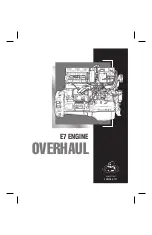
OC60-E2, OC95-E2, WSM
ENGINE
M-11
B
At Idling
When the speed control lever (1) is set in the idling
position, the governor spring (2) is almost relaxed and
the idling spring (6) of small tension alone is at work.
This idling spring works in the direction B (to increase
fuel supply). To the contrary, the governor weight (9)
extends by the centrifugal force in the direction of E to
push the governor shaft (3) and in turn move the
governor lever 1 (7) in the direction of D (to decrease the
fuel supply). The engine will idle in a condition in which
the two forces are balanced with each other.
B
At Idling to Maximum Speed
When The engine rotates at idling to maximum
speeds, engine rotates at a constant speed at the point
where the governor spring tension and the governor
weight's centrifugal force are well balanced. If the load
is increased, the engine speeds down and the
centrifugal force of the governor weight (9) becomes
smaller, so that the control rack (4) is moved in the
direction C in which fuel is increased to restore the
original speed. In this way, the engine speed is
automatically controlled for a constant revolution.
B
At Maximum Engine Speed
When the speed control lever (1) is moved in the
direction A, the governor weight (9) is at the maximum
centrifugal force, with the governor lever 3 (8)
contacting the fuel limiter (5). As the load becomes
large, the speed is reduced, decreasing the governor
weight's centrifugal force. Then, the governor lever
pushes the fuel limiter (the limiter contains a spring) and
moves in the direction F. Thus, the control rack (4) is
placed at the maximum fuel injection position, producing
the maximum engine output power.
B
At Engine Stop
When the governor lever (8) is moved fully in the
direction B to the stop position, the governor lever (7)
moves in direction D, thus the control rack (4) is set to
the stop position (No fuel injection) and the engine
stops.
0000009163E
0000009164E
0000009165E
0000009166E
















































